
The Sanseer Mill is a historic 19th-century mill at 282 Main Street Extension in Middletown, Connecticut. It was added to the United States National Register of Historic Places in 1986.

Westville Village Historic District is a historic district representing most of the commercial center of the Westville neighborhood of New Haven, Connecticut. This center developed in the 19th century as an industrial mill village distinct from the city center, and retains many architectural features of that period. The district was listed on the National Register of Historic Places in 2003, and its boundaries were increased slightly in 2006.

The Cheney Brothers Historic District was a center of the silk industry in Manchester, Connecticut, in the late 19th and early 20th century. The 175-acre (71 ha) district includes over 275 mill buildings, workers houses, churches, schools and Cheney family mansions. These structures represent the well-preserved company town of the Cheney Brothers silk manufacturing company, the first America-based silk company to properly raise and process silkworms, and to develop the difficult techniques of spinning and weaving silk. The area was declared a National Historic Landmark in 1978.

The Greenwich Mills is an historic mill complex at 42 Ladd Street in Warwick, Rhode Island. The complex was developed between 1918 and 1927, and includes four brick structures. The oldest is the weave shed, a single-story structure built in 1918. The office building was built in 1919–20, and is a 3- and 4-story C-shaped structure. This building was designed by Providence architect T. Clarence Herrmann. The finishing mill, built in 1923 and expanded in 1931, is the largest of the complex, and is located at the corner of Blackmore and Ladd Streets. The dye house and boiler house is a single-story structure built in sections in c. 1922 and 1947. The mills were built on a site where industrial activity had been taking place since about 1836. The mills produced worsted wool fabric until 1950, and are now used for a variety of light industrial purposes.

Quinebaug Mill–Quebec Square Historic District is a historic district roughly bounded by the Quinebaug River, Quebec Square, and Elm and S. Main Streets in the town of Brooklyn in Windham County, Connecticut. The district encompasses a well-preserved 19th-century mill village. It was added to the National Register of Historic Places in 1985.
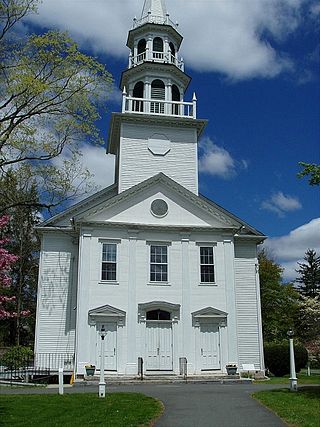
The South Britain Historic District encompasses the core of the unincorporated village of South Britain in Southbury, Connecticut, United States. The village arose in the 18th century as an industrial center serving the surrounding agricultural community, powered by the Pomperaug River, and rivalled the town center of Southbury in importance. The district was listed on the National Register of Historic Places in 1987.

The Whitney Avenue Historic District is a historic district in the East Rock neighborhood of New Haven, Connecticut. It is a 203-acre (82 ha) district which included 1,084 contributing buildings when it was listed on the National Register of Historic Places in 1989.

Narragansett Mills is a historic textile mill site located at 1567 North Main Street in Fall River, Massachusetts, United States. Built in 1872, it is a well-preserved example of a brick mill complex, somewhat unusual in a city where most of the mills are stone. It was listed on the National Register of Historic Places in 1983.
The city of New Haven, Connecticut has many distinct neighborhoods. In addition to Downtown, centered on the central business district and the Green, are the following neighborhoods: the west central neighborhoods of Dixwell and Dwight; the southern neighborhoods of The Hill, historic water-front City Point, and the harborside district of Long Wharf; the western neighborhoods of Edgewood, West River, Westville, Amity, and West Rock; East Rock, Cedar Hill, Prospect Hill, and Newhallville in the northern side of town; the east central neighborhoods of Mill River and Wooster Square, an Italian-American neighborhood; Fair Haven, an immigrant community located between the Mill and Quinnipiac rivers; Quinnipiac Meadows and Fair Haven Heights across the Quinnipiac River; and facing the eastern side of the harbor, The Annex and East Shore.

The Warrenton Woolen Mill is a historic textile mill at 839 Main Street in Torrington, Connecticut. Founded in 1844, the mill was a major part of the local economy until its closure in 1984. Its surviving complex, dating to the early 20th century, was listed on the National Register of Historic Places in 1987. It has since been renovated into housing, as the Warrenton Mill Condominiums.
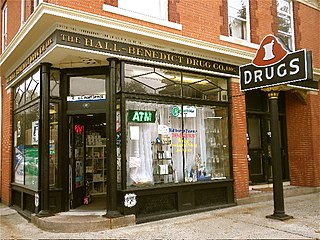
The Hall-Benedict Drug Company Building is a historic commercial building at 763-767 Orange Street in the East Rock neighborhood of New Haven, Connecticut. Built in 1909 to house a pharmacy, it is a little-altered and well-preserved example of an early 20th-century mixed residential-commercial neighborhood building. The building was listed on the National Register in 1986. It is also a contributing property in the Whitney Avenue Historic District.
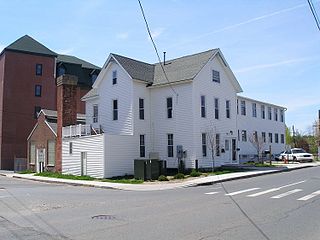
The Ball and Roller Bearing Company, also known as American Family Crafts and the Joseph Nutt House and Machine Shop, is a historic industrial complex at 20-22 Maple Avenue in Danbury, Connecticut. Developed mainly in the early 20th century, the factory is most notable as the location where Lewis Heim invented the modern grinding machine, which revolutionized the manufacture of machine parts. The complex was listed on the National Register of Historic Places on August 25, 1989. It now houses a church and social service agencies.

The Strouse, Adler Company Corset Factory is a historic factory complex at 78-84 Olive Street in New Haven, Connecticut. Developed between 1876 and 1923, it was the largest and oldest of the city's several corset manufacturers, and remained in continuous operation for that purpose until 1998. The complex was listed on the National Register of Historic Places in 2002. It has since been converted into residential use.

The River Street Historic District encompasses a historic industrial area in the Fair Haven section of New Haven, Connecticut. Located south of Chapel Street between James Street and Blatchley Avenue, the industrial buildings here date to New Haven's growth as a major industrial center between the American Civil War and World War I, with significant emphasis on metalworking businesses. The district was listed on the National Register of Historic Places in 1989.
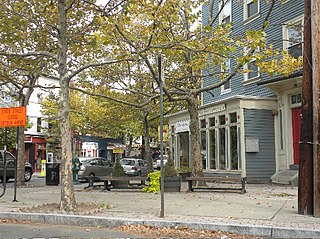
The Upper State Street Historic District encompasses a well-preserved neighborhood commercial district of the late 19th century in the East Rock neighborhood of New Haven, Connecticut. The district is an irregular strip running NNE to SSW mainly along State Street in New Haven, one block west of Interstate 91, the highway which determines the district's eastern and southern borders. The district was listed on the U.S. National Register of Historic Places in 1984.

The Depot Street Bridge is a historic bridge in Beacon Falls, Connecticut, carrying Depot Street over the Naugatuck River. Built in 1935 with federal jobs relief funds, it is one of a small number of surviving Parker through truss bridges in the state. It was listed on the National Register of Historic Places in 2007.

The Home Woolen Company is a historic textile mill complex on Main Street in Beacon Falls, Connecticut. Developed between 1853 and 1916, the complex housed major local employers, engaged first in the manufacture of woolens and rubber products. The complex has been converted to residential use. It was listed on the National Register of Historic Places in 1984.
The Andrews Mill Company Plant is a historic industrial complex at 761 Great Road in North Smithfield, Rhode Island. Built beginning in 1918, it was home to a maker of French worsted wool textiles, part of a major industrial development push in northern Rhode Island at the time. The complex was listed on the National Register of Historic Places in 2018.
The Moore Fabric Company Plant is a historic industrial complex at 45-47 Washington Street in Pawtucket, Rhode Island. The complex consists of five buildings built between 1878 and 1954, primarily for the purpose of manufacturing textiles with elastic components, although the oldest structure was built as a school. The complex was listed on the National Register of Historic Places in 2019. Plans have been laid to convert the property to residential use.
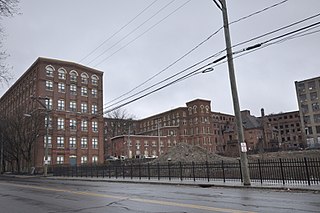
The Waterbury Clock Company factory is a historic complex of factory buildings in Waterbury, Connecticut. Developed beginning in the 1873, the extensive plant served as the company's main manufacturing facility and headquarters until 1944. The company is now known as the Timex Group USA, and was for a time one of the world's largest manufacturers of pocket watches. The surviving elements of the manufacturing complex were listed on the National Register of Historic Places in 1982. The property has since been subdivided and is home to a variety of primarily industrial or commercial uses.

















